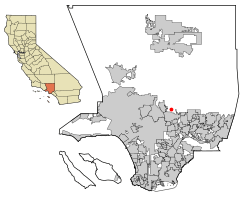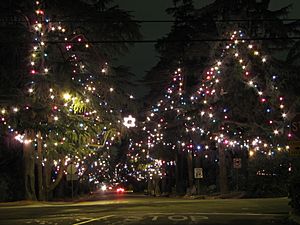Altadena, California facts for kids
Quick facts for kids
Altadena, California
|
||
|---|---|---|

Aerial view of Altadena and Eaton Canyon
|
||
|
||

Location of Altadena in Los Angeles County, California
|
||
| Country | ||
| State | ||
| County | ||
| Area | ||
| • Total | 8.48 sq mi (21.97 km2) | |
| • Land | 8.46 sq mi (21.92 km2) | |
| • Water | 0.02 sq mi (0.04 km2) 0.19% | |
| Elevation | 1,358 ft (414 m) | |
| Population
(2020)
|
||
| • Total | 42,846 | |
| • Density | 5,061.55/sq mi (1,954.26/km2) | |
| 2016 estimate: 45,001 | ||
| Time zone | UTC−8 (Pacific) | |
| • Summer (DST) | UTC−7 (PDT) | |
| ZIP Codes |
91001, 91003
|
|
| Area code(s) | 626 | |
| FIPS code | 06-01290 | |
| GNIS feature IDs | 1652662, 2407732 | |
Altadena () is a community in Los Angeles County, California. It is located about 14 miles (23 km) from downtown Los Angeles. Altadena is directly north of the city of Pasadena, California. It is called an "unincorporated area" because it doesn't have its own city government. Instead, it is managed by Los Angeles County. In 2020, about 42,846 people lived there.
Contents
What's in the Name?
The name Altadena comes from two words. Alta is a Spanish word meaning "upper." Dena comes from the name of the nearby city, Pasadena. So, Altadena means "Upper Pasadena" because it's next to Pasadena but at a higher elevation.
A Look Back: Altadena's History
Early Days and Water
In the 1860s, a man named Benjamin S. Eaton found ways to bring water from the Arroyo Seco and Eaton Canyon. This water helped grow crops and made it possible for Altadena, Pasadena, and South Pasadena to develop. He worked for B. D. Wilson and Dr. John Griffin, who owned a large piece of land called Rancho San Pascual. They wanted to sell this land, but it was hard to reach, and many didn't think crops would grow there.
In 1873, Eaton helped sell 4,000 acres of the rancho to a group of investors from Indiana. This land included what would become Altadena.
How Altadena Got Its Name
In 1875, Byron O. Clark started a plant nursery in the foothills. He called it "Altadena Nursery," using the name he created from "alta" and "dena."
Later, in the 1880s, brothers Capt. Frederick Woodbury and John Woodbury bought a large area of land. John Woodbury started the Pasadena Improvement Company in 1887. They wanted to build homes and asked Byron O. Clark if they could use the name "Altadena" for their new community. Clark agreed.
Millionaires and Mansions
Soon, wealthy people from the East Coast started moving to Altadena. Famous people like Andrew McNally (a printing boss) and George Gill Green built large homes on what was called Millionaire's Row. Newspaper owners William Armiger Scripps and William Kellogg also built homes there. The famous writer Zane Grey bought a house and added a study on the second floor.
A Diverse Community
For a long time, certain rules made it difficult for African Americans to buy homes in many parts of California. However, Altadena Meadows was one of the areas where these rules did not apply. It grew into one of the first strong middle-class African American neighborhoods in the area.
In the 1960s, Altadena saw big changes in its population. Many people moved into the area, and the community became much more diverse.
Protecting Its Identity
Over the years, the city of Pasadena has tried many times to add Altadena to its own city limits. But Altadena residents have always fought against this, wanting to keep their community independent. They have been successful in stopping these attempts.
Recent Events
In 1993, the Kinneloa Fire started accidentally and burned many homes in Altadena and a nearby area.
In 2022, Altadena made news when a resident gave her land to the Tongva Taraxat Paxaavxa Conservancy. This was a very important event because it was the first time in almost 200 years that the Tongva people, who are the original inhabitants of the Los Angeles Basin area, had land returned to them in Los Angeles County.
Altadena also gained national attention when a lottery ticket that won a world record $2.04 billion Powerball jackpot was sold there.
Where is Altadena?
Geography and Size
Altadena covers a total area of about 8.7 square miles (22.5 square kilometers). Almost all of this area is land.
Weather in Altadena
Altadena has hot and dry summers. The fall season is warm and windy, and winters are mild. This type of weather is called a hot-summer Mediterranean climate.
| Climate data for Altadena, California (1991-2020 averages, 1922-2016 extremes) | |||||||||||||
|---|---|---|---|---|---|---|---|---|---|---|---|---|---|
| Month | Jan | Feb | Mar | Apr | May | Jun | Jul | Aug | Sep | Oct | Nov | Dec | Year |
| Record high °F (°C) | 93 (34) |
92 (33) |
98 (37) |
105 (41) |
104 (40) |
113 (45) |
110 (43) |
107 (42) |
111 (44) |
108 (42) |
101 (38) |
93 (34) |
113 (45) |
| Mean daily maximum °F (°C) | 64.3 (17.9) |
64.4 (18.0) |
66.6 (19.2) |
67.0 (19.4) |
75.0 (23.9) |
79.1 (26.2) |
85.8 (29.9) |
86.8 (30.4) |
84.6 (29.2) |
76.9 (24.9) |
72.8 (22.7) |
65.8 (18.8) |
74.1 (23.4) |
| Mean daily minimum °F (°C) | 42.3 (5.7) |
43.9 (6.6) |
44.8 (7.1) |
45.9 (7.7) |
50.2 (10.1) |
52.9 (11.6) |
57.7 (14.3) |
59.1 (15.1) |
58.4 (14.7) |
51.8 (11.0) |
48.5 (9.2) |
44.6 (7.0) |
50.0 (10.0) |
| Record low °F (°C) | 21 (−6) |
26 (−3) |
29 (−2) |
31 (−1) |
32 (0) |
41 (5) |
45 (7) |
43 (6) |
41 (5) |
36 (2) |
26 (−3) |
25 (−4) |
21 (−6) |
| Average rainfall inches (mm) | 4.80 (122) |
5.74 (146) |
3.19 (81) |
1.29 (33) |
0.74 (19) |
0.21 (5.3) |
0.08 (2.0) |
0.01 (0.25) |
0.18 (4.6) |
0.91 (23) |
1.18 (30) |
3.04 (77) |
21.37 (543.15) |
| Average rainy days (≥ 0.01 inch) | 6.4 | 6.0 | 4.9 | 2.9 | 2.4 | 0.8 | 0.2 | 0.2 | 0.7 | 2.4 | 2.4 | 4.9 | 34.2 |
| Source 1: WRCC | |||||||||||||
| Source 2: WRCC | |||||||||||||
Altadena gets more rain than nearby Los Angeles. This is because of the orographic effect. This happens when moist air is forced up by the San Gabriel Mountains, causing more rain to fall on the mountain slopes.
Who Lives in Altadena?
| Historical population | |||
|---|---|---|---|
| Census | Pop. | %± | |
| 1960 | 40,568 | — | |
| 1970 | 42,415 | 4.6% | |
| 1980 | 40,983 | −3.4% | |
| 1990 | 42,658 | 4.1% | |
| 2000 | 42,610 | −0.1% | |
| 2010 | 42,777 | 0.4% | |
| 2020 | 42,846 | 0.2% | |
| sources: | |||
Altadena is a diverse community with people from many different backgrounds.
Population in 2020
In 2020, Altadena had a population of 42,846 people. The community is made up of many different groups, including White, African American, Native American, Asian, Pacific Islander, and people of two or more races. A significant portion of the population is also Hispanic or Latino.
Population in 2010
In 2010, the population was 42,777. About 98.8% of the people lived in homes. There were 15,212 households. Many households had children under 18. The average household had about 2.78 people. The median age was 41.8 years old. Most homes were owned by the people living in them. The median household income was $82,895.
Fun Things to See and Do
Places to Visit
- Christmas Tree Lane is a special road about 0.7 miles (1.1 km) long. Every December, the 110 giant deodar cedar trees lining the street are decorated with thousands of Christmas lights. This tradition started in 1920, making it the oldest large outdoor Christmas lighting display in the world! It's even listed on the National Register of Historic Places.
- The Balian Mansion used to have an amazing Christmas lighting display that attracted visitors from all over the world. It was lit up during the holidays from 1955 to 2016.
- The historic Mount Lowe Railway was a scenic train that took passengers high into the San Gabriel Mountains. While the railway itself isn't in Altadena, the main path to it, the Sam Merrill Trail, starts here. You can hike to Mount Echo, which is about 3 miles (4.8 km) away. The railway site is also on the National Register of Historic Places.
- Hiking Trails Altadena has many hiking trails. One popular trail leads to the Dawn Mine. You can follow arrows painted on large rocks to find your way.
- The Cobb Estate at the top of Lake Avenue is now a free botanical garden. It's run by the United States Forest Service. You can walk up its long driveway to where a grand mansion once stood. This area is also near the Sam Merrill Trail.
- Gen. Charles S. Farnsworth County Park is a large county park on Lake Avenue. It has picnic areas, playgrounds, a clubhouse, and an outdoor theater. It was added to the National Register of Historic Places in 1997.
- Crudely Hewn Tombstone is the grave of Owen Brown, who was an abolitionist and a survivor of John Brown's raid on Harpers Ferry. It's the only known memorial for him and is located in a quiet part of the Angeles National Forest.
- The Bunny Museum in Altadena is a unique place! It has more than 35,000 items related to rabbits, spread across 16 rooms.
Local Services
- The Los Angeles County Sheriff's Department (LASD) has a station in Altadena. They handle calls about crime.
- The California Highway Patrol has an office in Altadena. They handle traffic-related calls.
- The Los Angeles County Department of Health Services operates the Monrovia Health Center in Monrovia, which serves Altadena residents.
Famous People From Altadena
Many notable people have lived in or are from Altadena, including:
- Claude Akins, actor
- Maria Bamford, stand-up comedian
- Octavia E. Butler, author
- Richard Feynman, Nobel Prize-winning physicist
- Zane Grey, author
- Rodney King, known for a police beating incident
- Andrew McNally, businessman and publisher
- Marni Nixon, singer
- George Reeves, actor from Adventures of Superman
- Alice Walker, author of The Color Purple
Images for kids
-
Woodbury–Story House (1882), the home of Capt. John Woodbury.
See Also
 In Spanish: Altadena para niños
In Spanish: Altadena para niños





